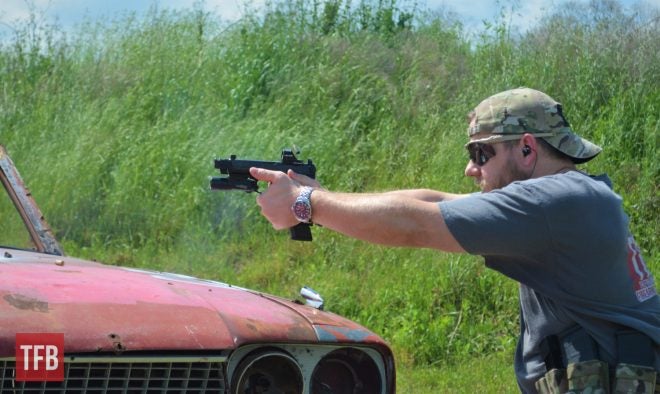Before releasing the first VP9 in 2014, Heckler & Koch had worked on the design for more than four years. Although they hadn’t been in the striker-fired pistol game for some time at that juncture, H&K was not new to the concept either, having pioneered the VP70 and P7 models more than three decades prior. Released in 1970 and 1979 respectively, these early striker-fired guns were not the norm at the time, as striker functionality wouldn’t begin seeing more widespread adoption until years later. The VP70 was notable for being the first polymer-framed handgun in production, predating first-gen Glocks by more than a decade. Both of these pistols enjoyed good reception and adoption, as well as a solid service history. In particular, the P7 managed to stay in production all the way until 2008, nearly thirty years after its introduction. Following the P7’s retirement in ’08, Heckler & Koch saw the writing on the wall. Although hammer-fired handguns and metal frames were by no means obsolete at that point, market demand was clear. Polymer frames and striker-fired mechanisms had essentially become the standard and were a must-have offering if a manufacturer hoped to compete in the pistol market. With a request from the Bavarian State Police to update their arsenal of aging P7s, in 2010 the German firm got back to work in this space.

The two VP9 versions I tested for this review update were the Tactical model and the L, or long-slide model.
TFB has provided prior coverage of the VP9 series before today’s update, including:
- [TFB GUNFEST] H&Ks New VP9 Upgrades and Accessories
- HK VP9 v. HK VP9B – Which magazine release
- [SHOT 2020] Industry Day At The Range – H&K Optics Ready VP9 and SP5
- [NRA 2019] H&K VP9L Long Slide Pistol
- H&K Trying to Press Americans’ Buttons With the New VP9-B Pistol
- TFB REVIEW: H&K VP9SK Subcompact Polymer Pistol
- Gun Review: A Tale of Two Volkspistoles: The H&K VP9 & VP40
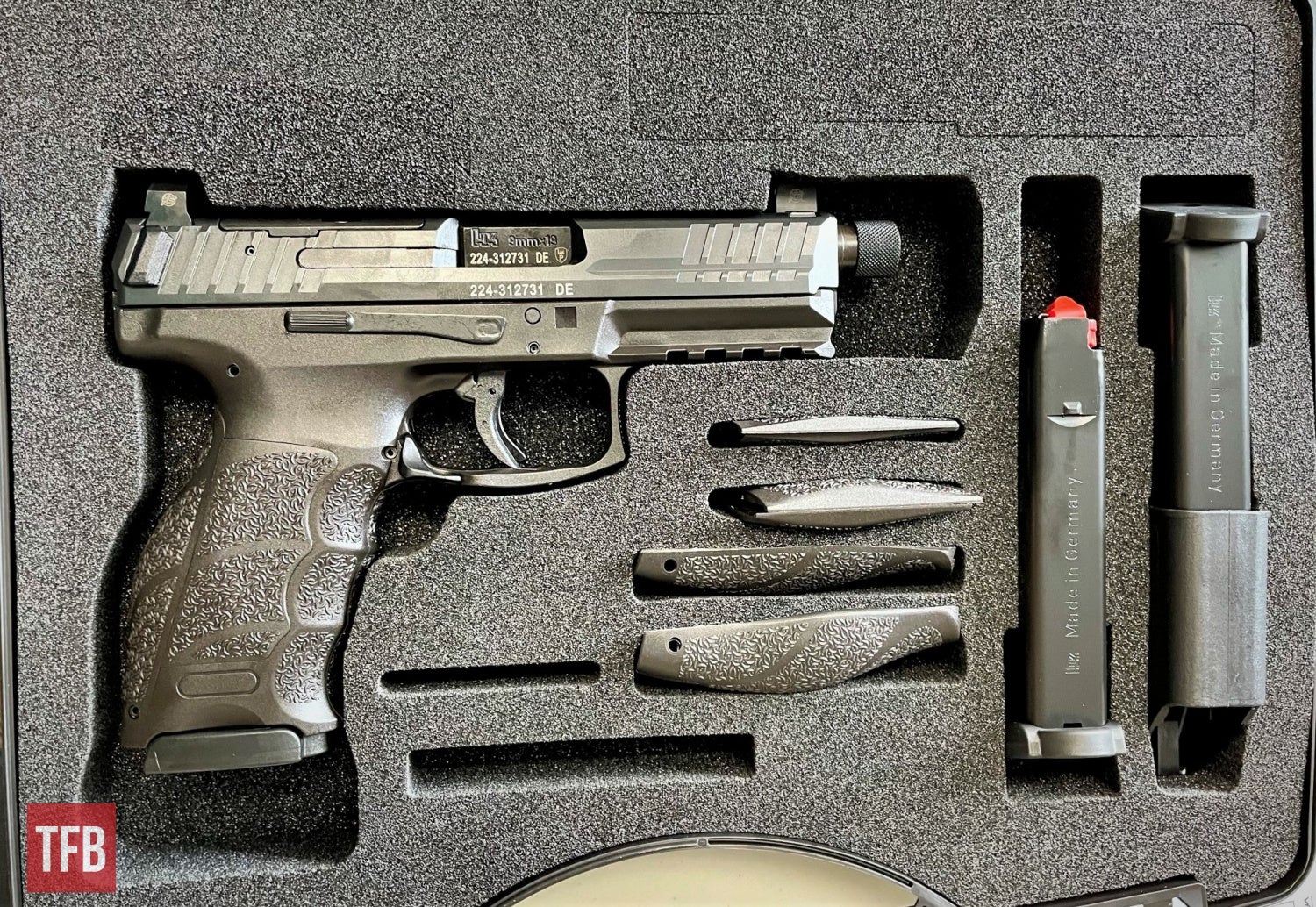
The VP9 Tactical comes as shown here, with the factory optics-cut slide, threaded barrel, and now 17-round mags instead of 15, as they used to include.
The idea behind the refreshed design was to create a new striker mechanism that would provide a crisp, clean-breaking trigger with a single-stage feel. Particularly, compared with their first foray into this field, the double-action-only VP70, the VP9 was meant to feel sharp and light, responsive and modern. Four years prior to the beginning of the VP9’s development, H&K had engaged in a similar modernization effort in the realm of hammer-fired handguns, resulting in the P30. Looking at these two models side-by-side clearly reveals that many of the successful elements of the P30 were carried over into the VP9. Most notably, the frames are clearly similar. You can see a few points of reshaping and refinement with the latter model, but much of the grip remains the same as the predecessor – similar texturing and finger grooves, the interchangeable backstrap/side panel system, and more. Other than the most visually obvious difference with the P30, its characteristic hammer, it also differs in a few other key areas, such as its slightly higher bore axis and alternative trigger options like double-action/single-action or double-action only.
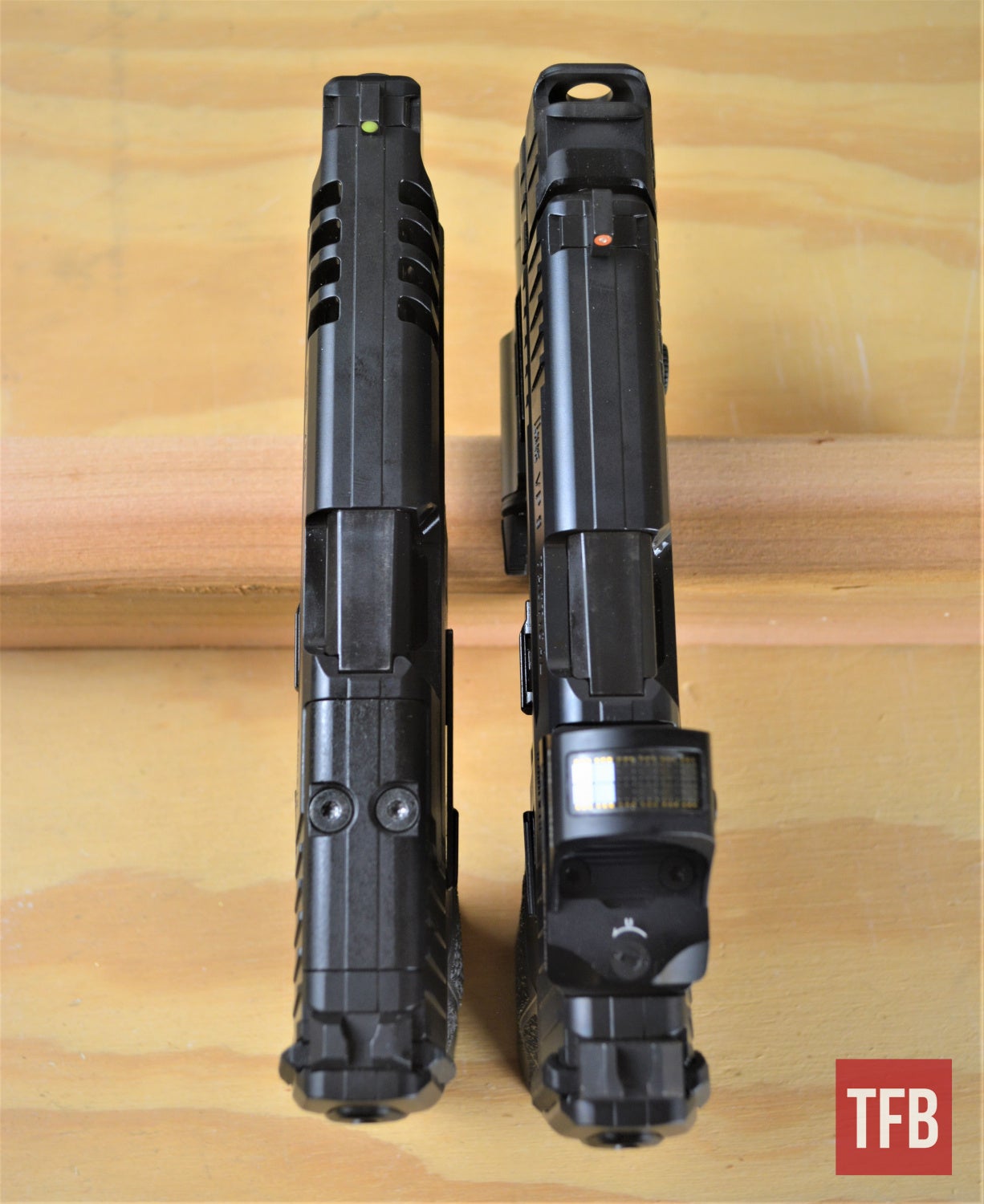
The addition of the Comp Tracker muzzle device, made for H&K by Parker Mountain Machine, brings the Tactical model to approximately the same overall length as the long-slide version.
Though the P30 has its fans, the design really came into its own with the VP9 evolution. Since the original’s release, other models have been added. Now in addition to the standard model, you can have a subcompact SK version, an aptly-named .40-caliber VP40, the Tactical model, a long slide “L”, and now a brand-new Match version. As you can see above, we’ve covered some of this in the past. So why the new review now? When H&K came to our GunFest event this past January, they let us know all about new updates for the VP9 series for 2020 and 2021. These include better sights, optics-ready slides throughout the series, a long slide conversion kit, and upgraded magazines. In light of these changes, they asked if we would provide an updated review, and I was glad to oblige. Today’s examination focuses on two models TFB hasn’t covered in quite as much depth as other versions. Over the last few months, I’ve gone in-depth with both the L (long-slide) and Tactical VP9s.
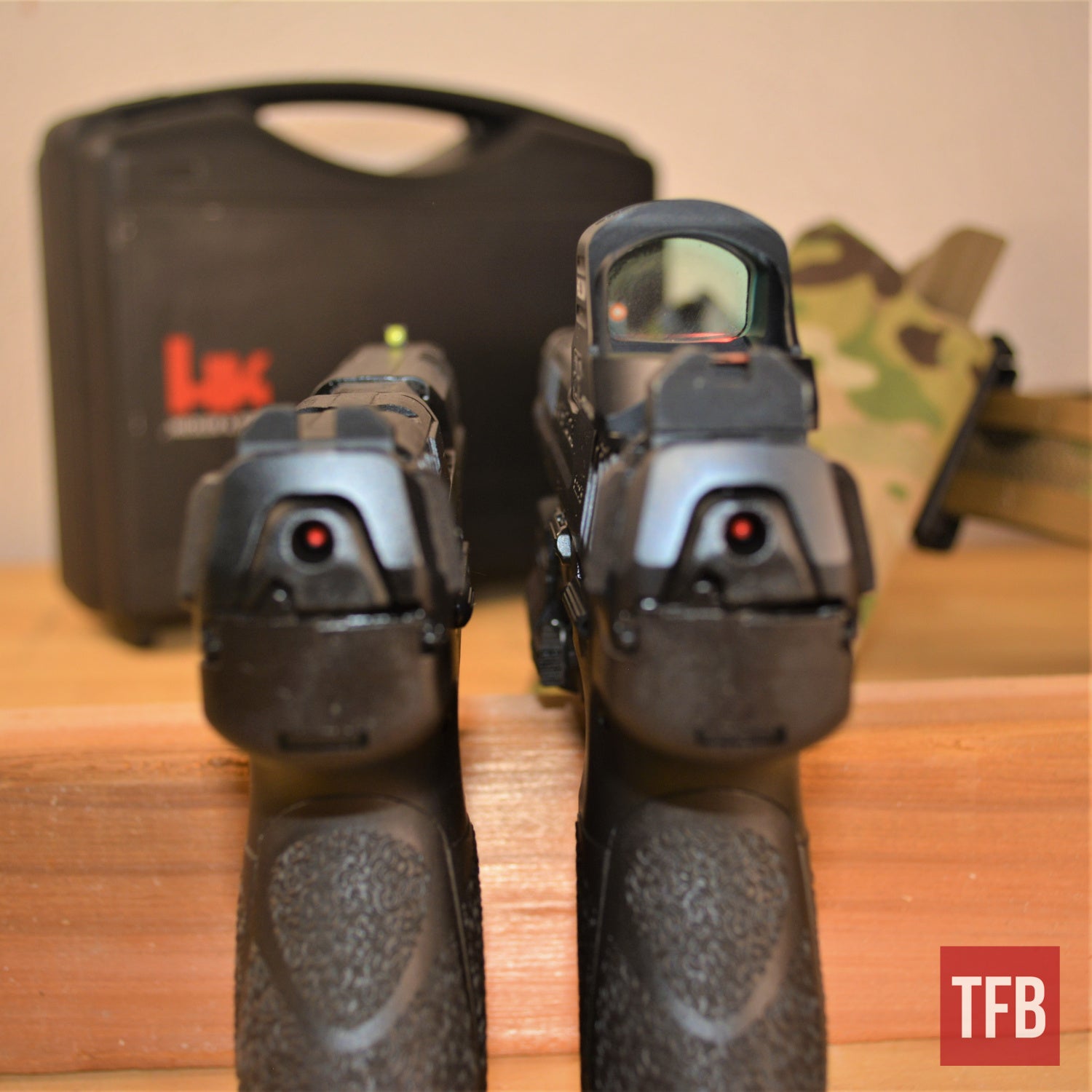
Here you can see the difference between the L model’s standard-height sights and the taller suppressor-height sights that the Tactical model comes with, which nicely compliment the factory threaded barrel.
A key component of H&K listening to their customers and staying current with market demand is the Optics Ready feature. In my opinion, these days if a manufacturer isn’t offering factory MRDS cuts on their handguns, at least as an option (if not as standard), they’re behind. The red dot revolution is well underway, and optics on sidearms are finding widespread acceptance with industry and training experts, from competition to EDC to mil/LE duty use and more. H&K has gotten on board with the MRDS modernization with their VP9s, and it’s absolutely the right call. Note: H&K’s mounting system requires a separate adapter plate, which they offer with a $29 MSRP in five versions for different MRDS footprints. Their #2 plate, compatible with the Trijicon/Holosun/Shield-style pattern, has been difficult to find in stock up to the time of this writing. H&K advises that they’re working hard on ramping up production to keep pace with demand. In the meantime, they’ve formed a partnership with third-party supplier Evolution Gun Works. EGW offers a copy of HK’s own branded model to fill the gap and provide that needed mount solution to VP9 owners who use these popular optics, as the OEM version gets spooled up.
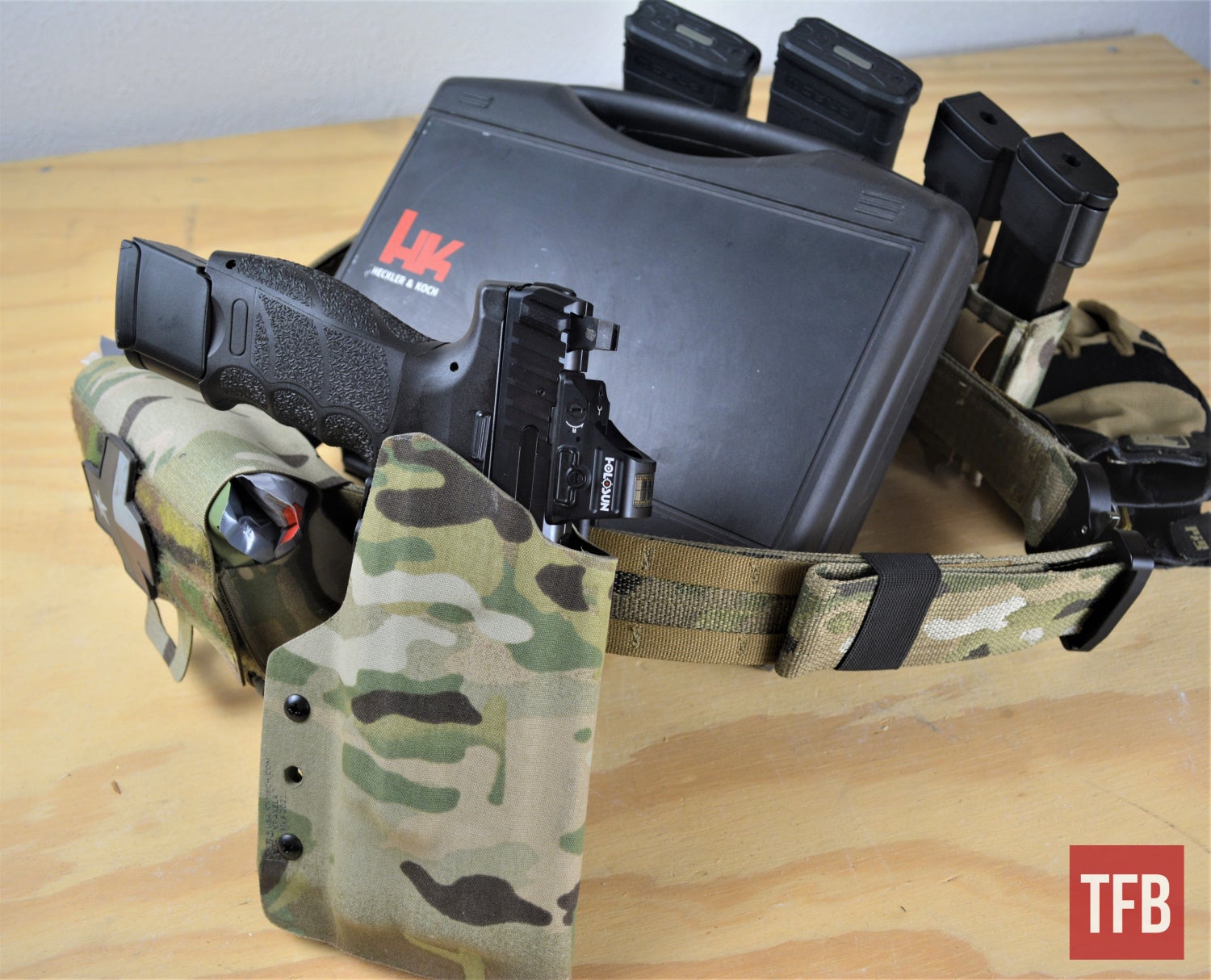
One of my favorite updates for the VP9 line is the addition of a 20-round magazine option. As long as the extension isn’t an issue for you, the capacity increase is great!
For those who still like iron sights, or at least want them available as a backup, our Deutsche freunde haven’t left you out. These handguns are available with some excellent tritium night sights, which were on both models I used. The L’s were low-rise, but the Tactical model I tested utilized suppressor-height sights, which provide clearance for most silencers and/or lower third co-witness through the window of an optic, if you do choose to make use of that slide cut. It’s a great setup, on both models. I’ve become mainly a red dot guy these days, but found these irons to function flawlessly in testing. They’re quick and easy to pick up and align, suitably bright without being overpowering or distracting in a variety of lighting conditions, and seem rock-solid in their construction and mounting. I put a Holosun 507C-X2 on the Tactical VP9 and used the Long-slide version’s irons only. No complaints whatsoever regarding either the old-school or new-school aiming methods with the VP9s.
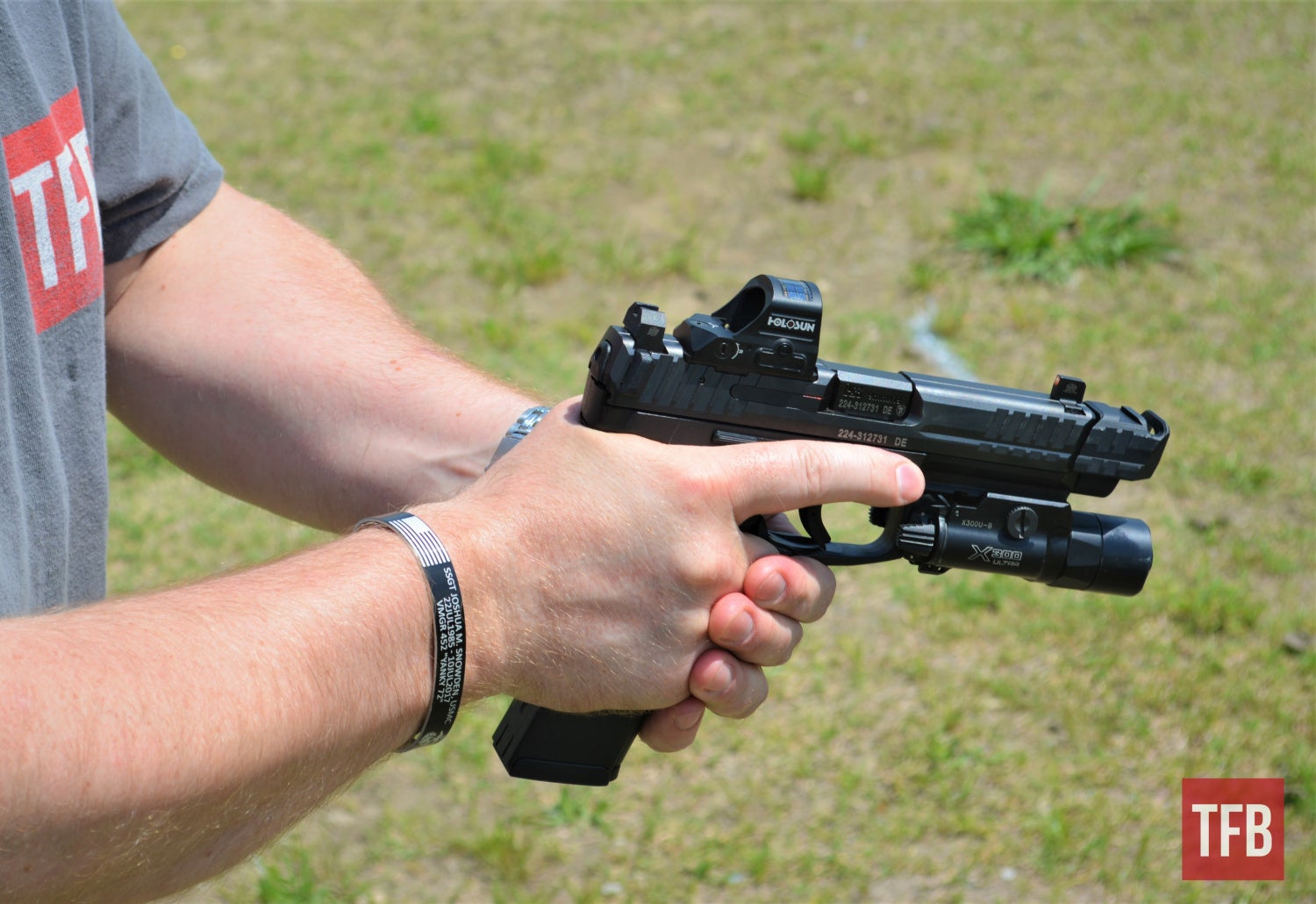
Both VP9 models felt great in the hand, with excellent ergonomics. The use of H&K’s customizable side panel and backstrap system definitely helps with that aspect.
Two of my favorite features were H&K’s magazines and the VP9 Tactical’s factory threaded barrel. Magazine capacity matters – it’s hard to have too many rounds available, but easy to have too few. Prior to the recent refresh, H&K was on par with their competitors in this area. You’d find 15-round mags in the box with the last iteration of the Tactical model, and 17 with the L. Now H&K is doing factory 20-round mags (compatible with the full VP9 range), which come standard with the L and are available as optional extras for the Tactical. The Tac’s default 15s have also been upped to 17s, which I again assess as the right move. When you compare these handguns with their closest colleagues from companies like Glock and SIG SAUER, this standard capacity increase can only make the VP9s look more competitive. I loved the feel and balance with the 20-rounders, and at no point thought it made the gun too heavy or extended compared with 15s or 17s. The Tac’s threaded barrel offers great attachment options without the need to go out and purchase an additional barrel, as many makes/models do. I like the option to run a can or leave it off and employ a thread protector, so this VP9 version fits that particular bill nicely. In this instance, however, I wanted to experiment with a different option: the controversial compensator.
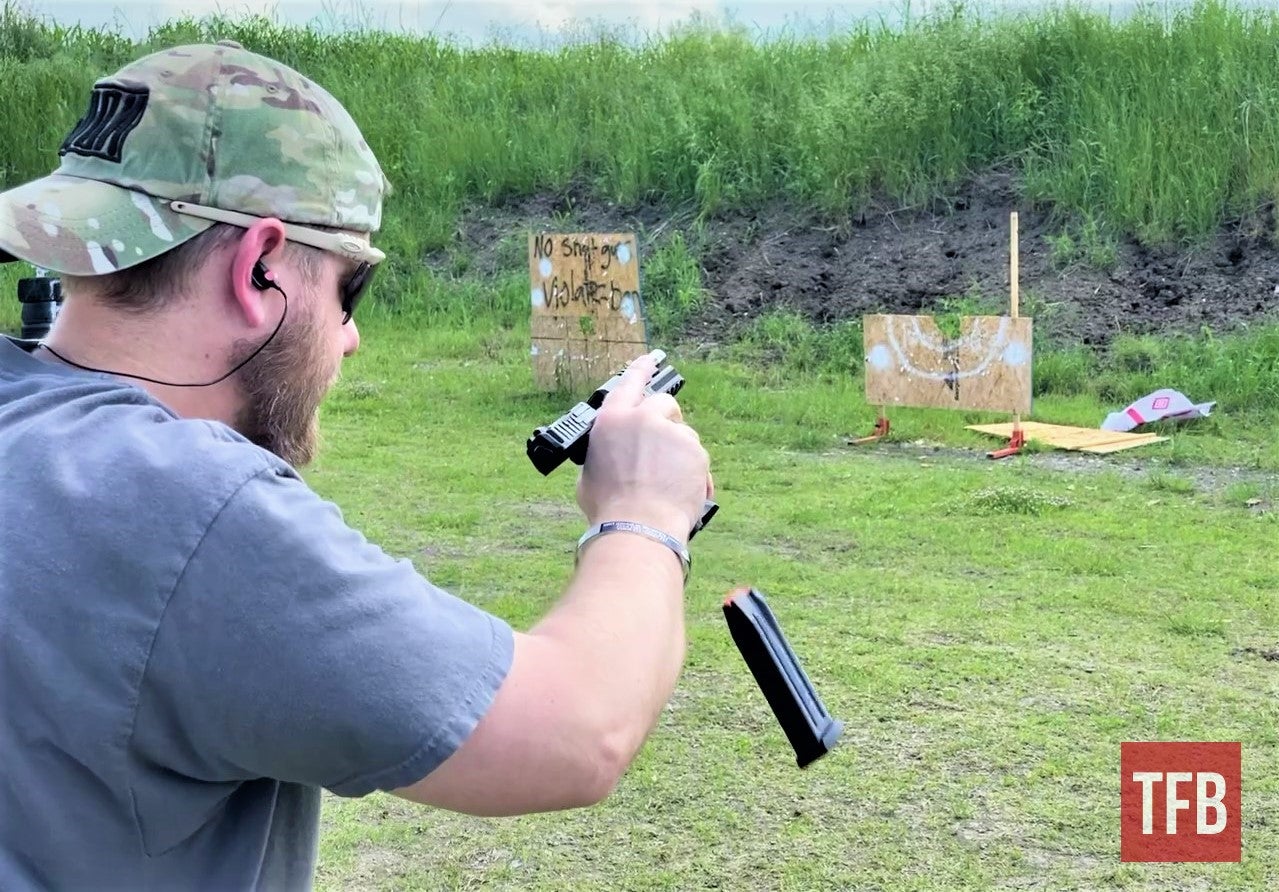
Both testers came with paddle mag releases. It didn’t take long to get used to them, even after years of using buttons, but H&K does offer push-button VP9s as well if you prefer. That said, give the paddles a chance – they’re great, too!
The practice of running comps on handguns generates a lot of both love and hate. Your mileage may vary. I went ahead and tried the “Sight Tracker” comp made for H&K by Parker Mountain Machine on the Tac’s threaded barrel. I didn’t notice a great benefit versus not using it, or versus the L model, and I did note that it looked like the Tac model wasn’t spitting out spent casings very far – markedly less than the L. This could be an indicator that the gun was struggling to cycle at full strength with the changes in weight/balance/pressure presented by the comp, which gave me some concern regarding long-term reliability. Unfortunately, I didn’t have the ammo budget during this project (thanks a lot, 2021 9mm prices) to run enough rounds to verify this fully, but the few ejection failures the gun produced during the 100 rounds I ran with the comp, coupled with the somewhat anemic ejection pattern noted above, were enough to give me pause. I feel more comfortable with the VP9 Tactical sans muzzle device. Running just the threaded barrel alone went fine in my experience. This also keeps your suppression option open, as the Sight Tracker device is affixed with Rocksett – so once it’s on there, it’s not coming off quickly or easily in the middle of a range session.

Obligatory action shot, with dissipating smoke/cycling slide/flying brass. The VP9 was thoroughly enjoyable to shoot!
In terms of function, feel, and shootability, the VP9s are excellent. Both versions I tested performed well, and felt great in my hands with comfortable ergonomics. The quality certainly seemed on par with the high-level standards you should be able to expect from a premier manufacturer like H&K. One note of which to be aware: these guns need a bit of prep before you first shoot them. I think it’s nice to know whether a gun is ready to shoot out of the box, or whether it needs an initial cleaning/lubrication/etc. Though I do believe it’s best practice to clean and lube any gun when you first bring it home anyway, I still find the straight-out-of-the-box test to be worth mentioning. Plenty of buyers don’t necessarily start with that disassembly process, so I want to give good guidance in this area. With the VP9s, they do need it. Both the Tac and L models were not fully range-ready out of the box, and had some cycling/extraction issues dry. Thankfully, a quick field strip with a bit of lubricant solved this easily. Once each handgun had been baptized and reassembled on the range table, they ran just fine for the rest of the session. Accuracy was top-notch, with the steel plates I was targeting easy to ring quickly and repeatedly. I expected a bit more muzzle flip compared to competitors, like Glock, due to the HK’s slightly higher bore axis. However, I’m glad to report that this was not really an issue for me. With a proper grip and solid control, I didn’t notice excessive poppy/snappy impulse. For me, both VP9s were quality shooters all around.
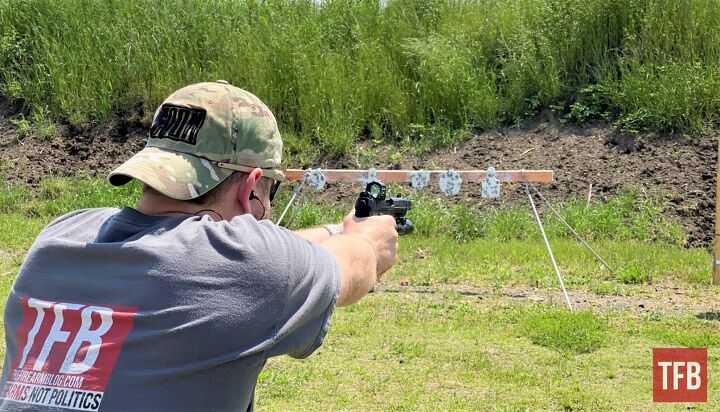
Bottom line: H&K already had a quality handgun in the VP9. Now with the recent upgrades to the mags, slides, and more, they’re even better. Definitely recommended!
Ultimately, if you’re in the market for a modern striker-fired pistol, the VP9 should be in your consideration set. It definitely belongs in the same class as its competitors from brands like Glock and SIG. The choices between the various makes, and between the VP9 variants themselves, come down to individual shooter preference. There’s nothing I experienced in handling either the VP9 Tactical or VP9L that leads me to recommend against choosing it. I’ve actually purchased a Tactical model for myself, which is currently sitting in my safe next to a Glock 19. If you want a long-slide gun, maybe for competition, absolutely look at the VP9L. If you want a compact pistol, the VP9SK warrants a look. If you want the option to run a comp or suppressor, the Tactical model is outstanding. Don’t let the paddle mag release dissuade you, either. I was accustomed to a push-button release prior to this deep-dive, but after a little bit of dry run practice, the paddle-and-flip reload technique became remarkably natural and smooth. But if you’re committed to buttons, no problem: HK offers button-equipped VP9s as well. With the model options, the Heckler & Koch quality, and recent updates to the series – unless they just don’t fit your hand in particular – I assess that there are fewer reasons than ever not to buy one of these excellent firearms. I’m glad I did! See you at the range.
Images courtesy of the author.
We are committed to finding, researching, and recommending the best products. We earn commissions from purchases you make using the retail links in our product reviews. Learn more about how this works.
 Your Privacy Choices
Your Privacy Choices
